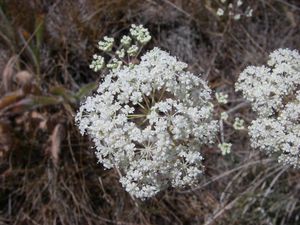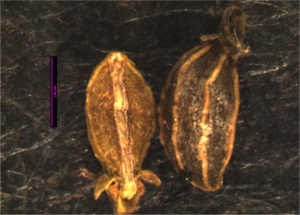Difference between revisions of "Perideridia montana"
(→The Seed) |
(→Taxonomy) |
||
| (27 intermediate revisions by 4 users not shown) | |||
| Line 1: | Line 1: | ||
| − | [[File: | + | * Scientific Name: ''Perideridia'' ''montana'' |
| − | ''Perideridia gairdneri | + | * Family: Apiaceae |
| + | * Common Names: mountain yampah, Gaidner's yampah | ||
| + | * Synonyms/Misapplications: ''Perideridia'' ''gairdneri'' (misapplied, Mathias, in previous Flora)'', Atenia'' ''montana, Carum'' ''garrettii, Carum'' ''montanum,'' ''P. g.'' subsp. ''bolanderi'' | ||
| + | * Codon: PERMON | ||
| + | ---- | ||
| + | [[File:PERMON2.jpg |thumb|Photo by Ron Bockelman, 2011, also featured on Main Page]] | ||
| + | ===Taxonomy=== | ||
| + | {{Taxobox | ||
| + | | image = | ||
| + | | image_caption =Photo by Ron Bockelman, 2011, Featured on Main Page | ||
| + | | name = | ||
| + | | regnum = [[Plant]]ae | ||
| + | | subregnum = Viridiplantae | ||
| + | | phylum = Tracheophyta | ||
| + | | subphylum= Magnoliophyta | ||
| + | | classis = Magnoliopsida | ||
| + | | subclassis = Asteranae | ||
| + | | ordo = Apiales | ||
| + | | familia = Apiaceae | ||
| + | | genus = ''Perideridia'' Richb. | ||
| + | | species = '''''Perideridia gairdneri''''' (Hook. & Arn.) | ||
| + | | subspecies = '''''Perideridia gairdneri'' ssp. '''borealis''''' T.I. Chuang & Constance | ||
| + | | synonyms= *''Atenia montana'' (Blank.) Rydb. | ||
| + | *''Carum montanum'' Blank. | ||
| + | *''Perideridia montana'' (Blank.) Dorn | ||
| + | }} | ||
| + | <ref>Integrated Taxonomic Information System. Retrieved from https://www.itis.gov/servlet/SingleRpt/SingleRpt?search_topic=TSN&search_value=29806</ref> | ||
| − | == | + | ===Description=== |
| − | + | '''Mature fruits needed for accurate identification.''' | |
| − | + | ||
| − | + | ||
| − | + | ||
| − | + | ||
| − | + | ||
| − | + | ||
| − | + | ||
| − | + | ||
| − | + | ||
| − | + | Glabrous perennial herbs from thickened tuberous edible roots. <ref name=":0" /> | |
| − | + | ||
| − | + | Leaves merely once or twice pinnate or ternate, the terminal segments long and narrow.<ref name=":1">Klinkenberg, Brian. (Editor) 2020. ''E-Flora BC: '' | |
| − | + | Electronic Atlas of the Plants of British Columbia'' [eflora.bc.ca]. Lab for Advanced Spatial Analysis, Department of Geography, University of British Columbia, Vancouver. [Accessed:'' | |
| − | = | + | 2020-06-03 12:05:29 AM |
| − | + | ]</ref> | |
| − | + | ||
| − | == | + | Inflorescence compound, spokes up to 6 mm at maturity, involucel bracts mostly setaceous, or absent. Flowers generally 5-7 veined Rays generally 11-16.<ref name=":1" /><ref name=":0" /><ref>Lincoln Constance & Margriet Wetherwax 2012, ''Perideridia gairdneri subsp. borealis'', in Jepson Flora Project (eds.) ''Jepson eFlora'', /eflora/eflora_display.php?tid=52099, accessed on June 02, 2020.</ref> |
| − | + | ||
| − | + | Fruit glabrous, sub-orbicular, 2-3 mm. long and wide, with prominent ribs. <ref name=":2" /> | |
| − | == | + | ===Bloom Period=== |
| − | + | July to August<ref name=":2">WTU Herbarium, Burke Museum, | |
| + | & University of Washington. Retrieved from <nowiki>https://biology.burke.washington.edu/herbarium/imagecollection/taxon.php?Taxon=Perideridia%20montana</nowiki></ref> | ||
| − | + | ===Distribution=== | |
| + | Southern BC south, on both sides of Cascades, to southern California, east to northern Great Plains, Wyoming and Colorado.<ref name=":0">Hitchcock, C. L., Cronquist, A., Giblin, D., & Legler, | ||
| + | B. et al. (2018). ''Flora of the Pacific Northwest: an illustrated manual''. | ||
| + | Seattle: University of Washington Press.</ref> | ||
| − | == | + | ===Habitat=== |
| − | + | Perideridia gairdneri prefers well-drained, nitrogen medium soils. It tolerates slightly acid to mildly alkaline soils. It is very shade intolerant. It is a climax species in drier sites, and is found in the meadow communities in Garry oak ecosystems. | |
| + | Grows from low to middle elevations.<ref name=":1" /> | ||
| − | + | ===Uses=== | |
| + | Important food plant in many places. | ||
| − | + | Newe use as a food, pit-roasted. | |
| − | + | Pomo staple food, roots and greens. | |
| − | + | ||
| − | == | + | Syilx food, eaten raw, boiled or cooked, sliced, dried and mixed with dried, powdered deer meat.<ref>Native American Ethnobotany Database. Retrieved from <nowiki>http://naeb.brit.org/uses/search/?string=Perideridia&page=1</nowiki></ref> |
| − | < | + | |
| − | === | + | ===Propagation=== |
| − | [[File:Pega seed.png|thumb | + | |
| + | ===Seed=== | ||
| + | [[File:Pega seed.png|thumb|300px|''Perideridia montana''<br> Photo Credit Lisa Hintz]] | ||
| − | + | Seed sample from 2011 | |
| − | + | ||
| − | Seed sample from 2011 | + | |
====Features==== | ====Features==== | ||
| Line 70: | Line 88: | ||
{{Basics}} | {{Basics}} | ||
| + | |||
| + | ===Photo Gallery=== | ||
| + | <gallery> | ||
| + | File:PERMON1.jpg| Photo by Ron Bockelman | ||
| + | File:PERMON4.jpg|seeds, photo by Roger T. George, 2016 | ||
| + | File:PERMON5.jpg|Inflorescence in fruit, photo by Roger T. George, 2016 | ||
| + | File:PERMON6.jpg|Understory with ''P. montana'', photo by Roger T. George, 2016 | ||
| + | </gallery> | ||
| + | |||
| + | ===References=== | ||
| + | <references /> | ||
Latest revision as of 22:20, 20 March 2021
- Scientific Name: Perideridia montana
- Family: Apiaceae
- Common Names: mountain yampah, Gaidner's yampah
- Synonyms/Misapplications: Perideridia gairdneri (misapplied, Mathias, in previous Flora), Atenia montana, Carum garrettii, Carum montanum, P. g. subsp. bolanderi
- Codon: PERMON
Contents
Taxonomy
| Scientific classification | |
|---|---|
| Kingdom: | Plantae |
| Subkingdom: | Viridiplantae |
| Phylum: | Tracheophyta |
| Subphylum: | Magnoliophyta |
| Class: | Magnoliopsida |
| Subclass: | Asteranae |
| Order: | Apiales |
| Family: | Apiaceae |
| Genus: | Perideridia Richb. |
| Species: | Perideridia gairdneri (Hook. & Arn.) |
| Subspecies: | Perideridia gairdneri ssp. 'borealis T.I. Chuang & Constance |
| Synonyms | |
| |
Description
Mature fruits needed for accurate identification.
Glabrous perennial herbs from thickened tuberous edible roots. [2]
Leaves merely once or twice pinnate or ternate, the terminal segments long and narrow.[3]
Inflorescence compound, spokes up to 6 mm at maturity, involucel bracts mostly setaceous, or absent. Flowers generally 5-7 veined Rays generally 11-16.[3][2][4]
Fruit glabrous, sub-orbicular, 2-3 mm. long and wide, with prominent ribs. [5]
Bloom Period
July to August[5]
Distribution
Southern BC south, on both sides of Cascades, to southern California, east to northern Great Plains, Wyoming and Colorado.[2]
Habitat
Perideridia gairdneri prefers well-drained, nitrogen medium soils. It tolerates slightly acid to mildly alkaline soils. It is very shade intolerant. It is a climax species in drier sites, and is found in the meadow communities in Garry oak ecosystems. Grows from low to middle elevations.[3]
Uses
Important food plant in many places.
Newe use as a food, pit-roasted.
Pomo staple food, roots and greens.
Syilx food, eaten raw, boiled or cooked, sliced, dried and mixed with dried, powdered deer meat.[6]
Propagation
Seed
Seed sample from 2011
Features
Average Measurement: 2.3 x 1 x 1
Measurement Range: L: 1.5 – 3, W: 0.8 – 1.1, D: 0.75 – 1.3
Latitudinal Cross Section: ovate
Longitudinal Cross Section: elliptical
Shape: Seed schizoid, flat on one plane, and rounded on the opposite plane. Lots of irregularity in shape.
Color: Various shades of green and brown. Hilum usually white. Some seeds have pink from remnant flower structure at apex opposite hilum.
Surface: Seeds have five ridges on outer seed face that run from hilum to opposite apex longitudinally. Inner seed face has one white rib that bisects the seed face.
Basic Explanations and Assumptions:
The dimensions for the seeds are length x width x depth. The location of the hilum is used as the base of the seed, and the length is measured from hilum to the opposite apex. Where a style is present, the length is measured from the hilum to the bottom of the style. Width is measured at a right angle to the length at the widest part. Depth is measured at a right angle to the intersection of height and width lines.
Measurements included are the mean average for each measurement of ten separate seeds.
All measurements in millimeters unless otherwise noted.
Photo Gallery
References
- ↑ Integrated Taxonomic Information System. Retrieved from https://www.itis.gov/servlet/SingleRpt/SingleRpt?search_topic=TSN&search_value=29806
- ↑ 2.0 2.1 2.2 Hitchcock, C. L., Cronquist, A., Giblin, D., & Legler, B. et al. (2018). Flora of the Pacific Northwest: an illustrated manual. Seattle: University of Washington Press.
- ↑ 3.0 3.1 3.2 Klinkenberg, Brian. (Editor) 2020. E-Flora BC: Electronic Atlas of the Plants of British Columbia [eflora.bc.ca]. Lab for Advanced Spatial Analysis, Department of Geography, University of British Columbia, Vancouver. [Accessed: 2020-06-03 12:05:29 AM ]
- ↑ Lincoln Constance & Margriet Wetherwax 2012, Perideridia gairdneri subsp. borealis, in Jepson Flora Project (eds.) Jepson eFlora, /eflora/eflora_display.php?tid=52099, accessed on June 02, 2020.
- ↑ 5.0 5.1 WTU Herbarium, Burke Museum, & University of Washington. Retrieved from https://biology.burke.washington.edu/herbarium/imagecollection/taxon.php?Taxon=Perideridia%20montana
- ↑ Native American Ethnobotany Database. Retrieved from http://naeb.brit.org/uses/search/?string=Perideridia&page=1






